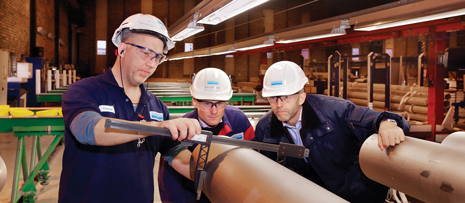 |
| Harsh downhole conditions are driving the need for superior materials. |
|
Standard stainless steels used in hydrocarbon production offer a number of advantages—such as corrosion resistance, economy and safety—compared to traditional low-alloyed materials. Nevertheless, these standard grades are proving insufficient in deeper, more hostile environments that contain corrosive elements, such as carbon dioxide (CO2), hydrogen sulfide (H2S) and chlorides.
These challenges are placing ever-greater importance on the selection of materials that can enable and sustain high levels of productivity, while, simultaneously, minimizing the risk of leaks and failures in the production tubing. Further investigations and qualification tests are increasingly vital to ensure that a selected material will perform, as expected, during operations.
Similarly, it is imperative to be fully aware of the complete mix of corrosive elements, which are present in the operating environment. The selection of materials for operations in highly sour environments is based on guidelines from NACE MR 0175/ISO 15156:2003, paragraph 7.
PARTIAL PRESSURES AND CORROSIVITY
To better understand material selection, it is necessary to examine the parameters that determine the risk of corrosion in oil and gas wells. Corrosivity in wet sour wells is increased by the presence of chlorides in water solutions, CO2 and H2S. An environment is considered “sweet,” as long as no H2S is present. However, CO2, alone, can cause high corrosion rates on carbon steel, and does so by acidifying the solution, a process that is further accelerated if chlorides are present.
Alternatively, an environment is defined as “sour” when the partial pressure of H2S is above 0.05 psi. This increased total pressure has only an indirect effect on corrosivity by increasing partial pressures of H2S and CO2 (PH2S and PCO2), which, in turn, determine the amount of H2S and CO2 that will be dissolved in the water phase. Meanwhile, the partial pressure of CO2 influences corrosion only indirectly through its influence on pH.
Put simply, higher partial pressures substantially increase the corrosion rate on carbon steels, due to the flow velocity and the partial pressure of CO2, which makes the water phase more acidic and also forms an iron-sulfide scale.
Instead, the major issue with stainless steels is the risk of localized corrosion, especially with regard to sulfide stress cracking (SSC), which causes failures in standard alloy stainless steels. Because of this, the partial pressure of CO2 and flow velocity can be excluded as factors that determine the risk of corrosion in oil and gas wells. The remaining four corrosion risk parameters are the pH and chloride contents of the water phase, the partial pressure of H2S and the temperature.
HIGH-ALLOYED MATERIALS
It is generally accepted that cold worked high-alloyed materials are best-suited for use in the types of severe environments encountered in deepwater oil and gas wells. These materials can, in theory, enable engineers to explore and extract hydrocarbons more economically. Their mechanical properties are designed to bear all the stresses that occur during operations, and produce a high-tensile material with strong resistance to corrosion phenomena, such as SSC and stress corrosion cracking (SCC).
However, these materials have been shown to exhibit service limitations in corrosive environments—especially in HPHT fields, where there is a high presence of chlorides in formation water. H2S and CO2 gases are prevalent in these wet conditions and high temperatures, and expose high-alloyed components to the risk of both SCC and SSC. To address these performance limitations, end-users should perform a test to ensure that the selected material is suitable for application in their field.
HYDROGEN EMBRITTLEMENT
Research into the use of standard alloy steels in sour environments has found that the failure of components—i.e. the fracturing of a production tubular caused by a corrosion attack—can be attributed to inappropriate use in the field. These inappropriate uses were exacerbated by a highly corrosive aggregation of hydrochlorides, H2S and H2O.
An example of component failure is illustrated in Fig. 1, which shows an examination of material Duplex 2205 with a 125-ksi minimum yield strength, an outside diameter (OD) of 88.90 mm x 6.45-mm wall thickness (w.t.) and a coupling size of 98.50 mm OD x 12.18-mm w.t. Further investigation revealed that the component had suffered due to embrittlement, which was caused by hydrogen introduced by H2S. This phenomenon—hydrogen embrittlement—commonly causes various metals, particularly high-strength steels, to become brittle and fractured, due to hydrogen exposure at low temperatures (194°F).
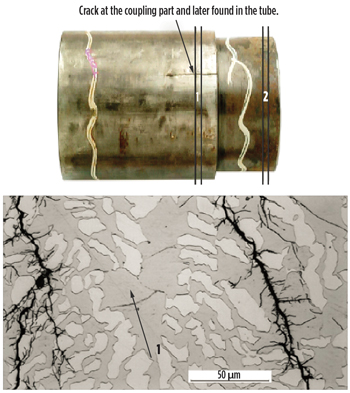 |
| Fig. 1. An example of failure at inappropriate application; microstructure examination under 500X magnification. |
|
DUPLEX STEELS
Engineers at Sandvik Materials Technology have identified several desirable chemical characteristics in a replacement grade for standard stainless steels: specifically nickel (Ni), chromium (Cr) and molybdenum (Mo). The engineers also concluded that stainless steels with greater resistance to low temperatures should be used as the main selection of materials.
Sandvik’s findings are reflected in its duplex material production and development. Since the 1970s and 1980s, the company has produced duplex stainless steels, which offer combined corrosion resistance and high mechanical properties that are superior to standard high-alloyed grades. These duplex grades also make it possible to replace carbon steels with stainless steels, without an extensive redesign. The products include Sandvik SAF 2205, Sandvik SAF 2304, Sandvik SAF 2507 and Sandvik SAF 3207 HD (UNS S33207), and the earlier grade Sandvik 3RE60 (UNS 31500).
A crucial advantage of the materials is their complete resistance to corrosion in wells rich in CO2, with a high amount of chlorides in the water phase. There is still no general corrosion, if H2S is present. Of these grades, it is necessary to identify the grade with the least risk of localized corrosion, especially with regards to SSC. Figure 2 illustrates a comparison of these materials’ resistance to SCC, alongside standard AISI 304 and 316 grades. While the diagram and grading of materials is based on environments where oxygen is present—and can therefore differ from oil wells which, typically, contain no oxygen—the findings indicate that Sanicro 28 outperformed the duplex stainless steels.
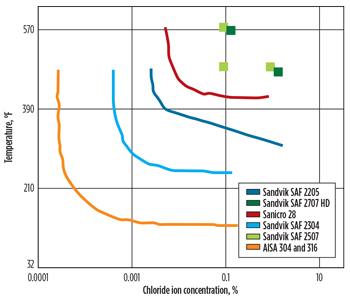 |
| Fig. 2. A comparison of several commonly used materials’ resistance to SCC. |
|
Sanicro 28 (UNS N08028) is a high-alloy, austenitic stainless steel designed for service in highly aggressive, corrosive environments. The material has good resistance to seawater and marine environments, combined with excellent resistance to H2S.
Although the grade was initially designed for sulphuric acid and phosphoric acid production—in either pipes or heat exchangers—subsequent developments have made it extremely useful in both upstream and downstream applications. The grade is especially useful for downhole production tubing, for which it is supplied in cold worked condition to achieve high strength.
The chemical composition of Sanicro 28 (Table 1) has characteristics that are favorable in replacement grades for downhole tubulars in sour gas wells, containing 30.3-34 w.t.% Ni, 27% Cr and 3.5% Mo. Combined, these elements imbue the material with a pitting resistance equivalent (PRE) minimum value of 38. PRE is a measurement of the corrosion resistance of stainless steel containing chrome, molybdenum, tungsten and nitrogen. It can be calculated as follows: PRE= %Cr + 3.3%Mo + 16%N (% by weight). For duplex stainless steels, the pitting corrosion resistance is proportional to the PRE number of an alloy, and, generally speaking, a higher PRE value indicates steel that is more corrosion-resistant.
| Table 1. Sanicro 28 chemical composition (nominal values). |
|

|
The nominal Ni content in Sanicro 28 is significantly higher than standard alloy stainless steels’ 304L/316L grade. The element acts as an important austenitic stabilizer, encouraging resistance to SCC, and improves the material’s mechanical properties and fabricability. In practical terms, combined high-alloying Ni and Cr elements imbue Sanicro 28 with considerably better resistance to sodium hydroxide than standard stainless steels of AISI 304 and AISI 316 types.
LABORATORY TEST
ISO 7539 test procedures qualify a component whenever the aggressiveness of the downhole environment gets close to the service boundary of the material. This is normal practice, to verify whether a material is suitable to serve in given well conditions. According to NACE MR0175-ISO 15156-3 guidelines, Sanicro 28, in solution-annealed and cold worked condition, is categorized in the solid solution, nickel-based alloy group, 4c.
This category is reserved for any material that is recommended for use in downhole equipment and, as detailed in Table 2, pertains to the grade’s reaction to the four main corrosion risks in oil and gas wells: pH and chloride content of the water phase, the partial pressure of H2S and the temperature.
| Table 2. Taken from NACE MR0175-ISO 15156-3 table A.14. |
|
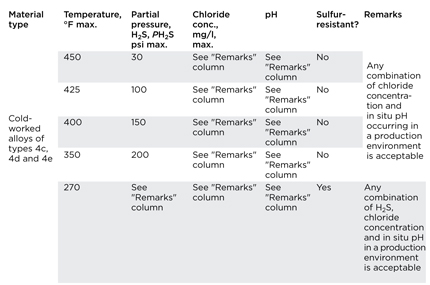
|
The material’s categorization at type 4c is confirmed in data from performance tests conducted under laboratory conditions. As shown in Fig. 3, the material, in cold-worked condition, demonstrated excellent resistance to SCC/SSC attacks in H2S environments. In Fig. 3, any condition below the line is a “no-corrosion attack region;” this also represents a safe region considering that the material’s CO2 partial pressure (594.65 psi) is much lower than the test pressure, and chloride content (75,000 ppm) is also lower than the test condition (90,000 ppm). The testing time was 500 hr. From the findings illustrated in this figure, it can be concluded that Sanicro 28 is sufficient for deep, sour wells.
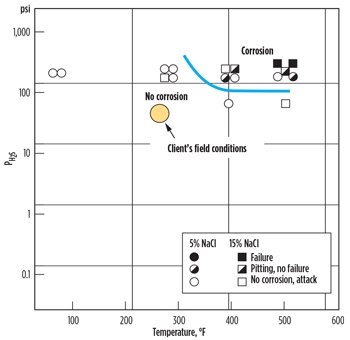 |
| Fig. 3. Sanicro 28 laboratory sour test result. |
|
AUTOCLAVE TEST
In addition to the laboratory test, qualities of Sanicro 28 were further assessed with SSC tests in simulated aggressive environments over a 720-hr period, in accordance with ISO 7539-1 and ISO 7539-4.
In preparation for the H2S autoclave test, the first stage of the assessment simulated the low oxygen levels of deep, sour wells—sometimes as low as 5–8 ppb—which are shown to significantly increase the corrosion rate of standard steels. Two sub-sized specimens, in solution-annealed and cold worked condition, were stressed to the desired test stress and placed in 250 ml of deaerated test solution. They were then further deaerated with oxygen-free nitrogen for 2 hr and pressure tested to 870 psi with nitrogen gas.
To better simulate high-pressure conditions, the tests were performed in autoclaves. This was achieved using Cortest Inc. ¼ l autoclaves and calibrated proof rings, performed at a stress level of 90% of the actual 0.2% proof stress of the material at test temperature, to equal a stress level of 712.8 N/mm2.
The next stage of the assessment focused on high-temperature and further corrosion tests. Nitrogen gas was vented, and the solution saturated with H2S gas at 100–200 ml per min. for 2 hr, at room temperature and at 55 psi pressure. Finally, the specimens were heated to 302°F ± 37.4°F, and any excess pressure was bled from the autoclave, resulting in a pressure of 783 psi. The autoclave was monitored for temperature and pressure. The engineers found there to be no cracks in the tested specimens after 720 hr of exposure.
Following these positive results, Sandvik conducted further assessments of the material’s resistance to SSC in u-bent forms, under the specified working condition of a sour environment at pressure. The specimens were stressed up to 90% of their yield strength, to replicate even more extreme conditions than the gas field, to accelerate the corrosion attack. After 720 hr of testing, microscopic examination confirmed that there were no cracks in the specimens, which further corroborates the material’s suitability for application in deepwater environments.
PERFORMANCE COMPARISON
The performance capabilities of Sanicro 28, in different sour well environments, were also compared to Sandvik SAF 2205, a duplex (austenitic-ferritic) stainless steel with excellent resistance to CO2 corrosion and to sour corrosion at moderate partial pressures of H2S, with superior anti-corrosion properties to steels of ASTM 316L type.
These comparison tests simulated the severe corrosion conditions found in sour gas wells, while systematically varying the important parameters, to determine environments in which the assessed materials do not corrode. The tests were made with tensile specimens, deadweight loaded to yield strength at the actual test temperature. These specimens were fully exposed to an aqueous phase with defined temperature, NaCl content and PH2S. They were then taken from tube walls in the longitudinal direction.
If no failure due to SCC had been found to occur, the tests were ended after the 720-hr test period. Figure 4 illustrates the performance of Sanicro 28 against the standard 13Cr grade, and the lines in each diagram represent the upper limit where no stress cracking occurred. In general terms, the test shows that the material has a higher resistance to SSC, compared to 13Cr.
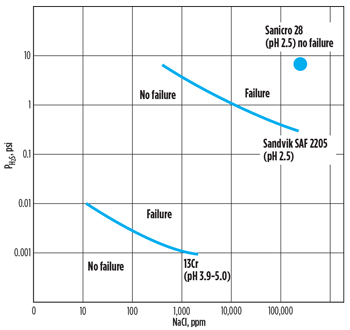 |
| Fig. 4. Atmospheric pressure SSC tests on production tubes of 13Cr – 80 ksi, Sandvik SAF 2205/22Cr – 110 ksi, and Sandvik Sanicro 28 – 110 ksi at 100°C (200°F). Load = Rp0.2 at testing temperature. |
|
SSC tests at 212°F are illustrated in Fig. 4, featuring 13Cr tube alongside Sanicro 28 and Sandvik SAF 2205. The test environments were H2O with different partial pressures of H2S and NaCl contents. As is apparent in this figure, 13Cr failed, due to SSC and pitting, at very low chloride contents and partial pressures of H2S, despite the rather high pH of the solution (pH 3.9–5.0).
Both materials were tested in a solution acidified with acetic acid to pH 2.5. The addition of acetic acid is a way of decreasing the pH and, therefore, simulating the actual CO2 in gas wells. A pH value of 2.5 corresponds to a PCO2 exceeding 1,450 psi and has a very strong effect on the maximum allowable PH2S. Despite the low pH, Sandvik SAF 2205/22Cr resisted several magnitudes higher partial pressures of H2S than 13Cr, while Sanicro 28 was resistant to cracking at 25% NaCl and the highest possible PH2S, which was 5.5 psi, and, therefore, exhibited no failure.
CONCLUSIONS
Test results in accordance with ISO guidelines show that replacement Sanicro 28 tubing exhibits extremely high corrosion resistance in strong acids, along with very good resistance to SCC and intergranular corrosion in various environments, particularly those where H2S is present, together with chlorides.
The material’s key qualities are a higher resistance to stress corrosion, and a resistance to sulfuric acid corrosion that is superior to traditional AISI materials. Sanicro 28, therefore, offers superior corrosion resistance in seawater-cooled, chloride-bearing cooling water with greater resistance to low temperatures. For these reasons, Sanicro 28 is the best-suited material to withstand prevailing conditions in deepwater offshore fields and sour wells. 
|









